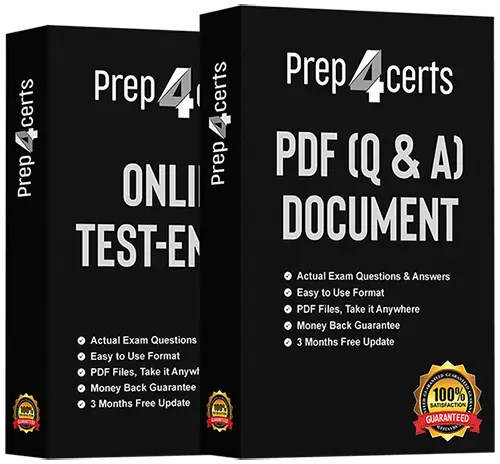
| Exam Code | DP-300 |
| Exam Name | Administering Relational Databases on Microsoft Azure |
| Questions | 341 Questions Answers With Explanation |
| Update Date | November 08,2024 |
| Price |
Was : |
Are you ready to take your career to the next level with Administering Relational Databases on Microsoft Azure? At Prep4Certs, we're dedicated to helping you achieve your goals by providing high-quality DP-300 Dumps and resources for a wide range of certification exams.
At Prep4Certs, we're committed to your success in the Microsoft DP-300 exam. Our comprehensive study materials and resources are designed to equip you with the knowledge and skills needed to ace the exam with confidence:
Start Your Certification Journey Today
Whether you're looking to advance your career, expand your skill set, or pursue new opportunities, Prep4Certs is here to support you on your certification journey. Explore our comprehensive study materials, take your exam preparation to the next level, and unlock new possibilities for professional growth and success.
Ready to achieve your certification goals? Begin your journey with Prep4Certs today!
You have an Azure subscription that contains the resources shown in the following table. App1 experiences transient connection errors and timeouts when it attempts to access db1 after extended periods of inactivity. You need to modify db1 to resolve the issues experienced by App1 as soon as possible, without considering immediate costs. What should you do?
A. Increase the number Of vCores allocated to db1.
B. Disable auto-pause delay for dbl.
C. Decrease the auto-pause delay for db1.
D. Enable automatic tuning for db1.
You have an Azure subscription that contains the resources shown in the following table. App1 experiences transient connection errors and timeouts when it attempts to access db1 after extended periods of inactivity. You need to modify db1 to resolve the issues experienced by Appl as soon as possible, without considering immediate costs What you do?
A. Increase the number of vCores allocated to db1.
B. Decrease the auto-pause delay for db1.
C. Disable auto-pause delay for db1.
D. Enable automatic tuning for db1.
You have a new Azure subscription. You create an Azure SQL Database instance named DB1 on an Azure SQL Database server named Server1. You need to ensure that users can connect to DB1 in the event of an Azure regional outage. In the event of an outage, applications that connect to DB1 must be able to connect without having to update the connection strings. Which two actions should you perform? Each correct answer presents part of the solution. NOTE: Each correct selection is worth one point.
A. From the properties of DB1. configure geo-replication.
B. From the properties of Server1 add a failover group.
C. Create a new Azure SQL Database server named Server2.
D. From the properties of Server1 configure retention for DB1
E. Create a new Azure SQL Database instance named DB2.
You have a Microsoft SQL Server 2017 server. You need to migrate the server to Azure. The solution must meet the following requirements: • Ensure that the latest version of SQL Server is used. • Support the SQL Server Agent service. Minimize administrative effort. What should you use?
A. SQL Server on Azure Virtual Machines
B. Azure SQL Database
C. an Azure SQL Database elastic pool
D. Azure SQL Managed Instance
Your on-premises network contains a Microsoft SQL Server 2016 server that hosts a database named db1. You have an Azure subscription. You plan to migrate db1 to an Azure SQL managed instance. You need to create the SQL managed instance. The solution must minimize the disk latency of the instance. Which service tier should you use?
A. Hyperscale
B. General Purpose
C. Premium
D. Business Critical
You have an Azure subscription that contains the resources shown in the following table. You need to configure a connection between VM1 and MIL The solution must meet the following requirements: • The connection must be encrypted. • Network latency must be minimized. What should you implement?
A. virtual network peering
B. private endpoints
C. service endpoints
D. a site-to-site VPN
You have a on-premises Microsoft SQL Server named SQL1 that hosts five databases. You need to migrate the databases to an Azure SQL managed instance. The solution must minimize downtime and prevent data loss. What should you use?
A. log shipping
B. Always On availability groups
C. Database Migration Assistant
D. Backup and Restore
You have an Azure SQL managed instance named MI1. You need to implement automatic tuning for the databases of MI1. What should you do?
A. Use the REST API to call the patch operation and modify the AutomaticTuningServerMode property.
B. Use Transact-SQL to enable the force_last_good_plan option.
C. From the Azure portal, configure automatic tuning.
Your on-premises network contains a server that hosts a 60-TB database named DB 1. The network has a 10-Mbps internet connection. You need to migrate DB 1 to Azure. The solution must minimize how long it takes to migrate the database. What should you use?
A. Azure Migrate
B. Data Migration Assistant (DMA)
C. Azure Data BOX
D. Azure Database Migration Service
You have an instance of SQL Server on Azure Virtual Machine named SQL1. You need to monitor SQL1 and query the metrics by using Kusto query language. The solution must minimize administrative effort. Where should you store the metrics?
A. a Log Analytics workspace
B. Azure Event Hubs
C. Azure SQL Database
D. an Azure Blob storage container